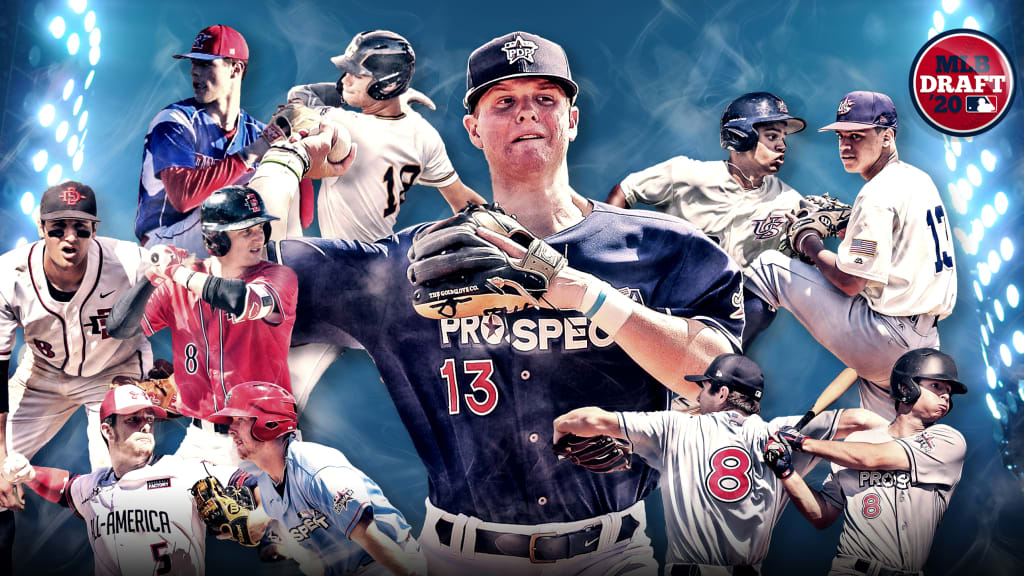
Two-way players have been a hot trend at the Major League level, with the Angels' Shohei Ohtani leading the way, followed by Rays prospect Brendan McKay and Reds right-hander/outfielder Michael Lorenzen. Then there are lesser-known players, like the Angels' Jared Walsh, who got the opportunity to both pitch and hit at the higher levels and has enjoyed success in both roles.
But with the 2020 Draft reportedly having been shortened due to the ongoing pandemic, teams have less incentive this year to gamble on potential two-way pro prospects as they target the best bang for their buck based on their limited numbers of picks and overall bonus pools.
That’s not to say that this year’s class is short on two-way guys. In fact, there are many notable names on MLB Pipeline’s Top 200 Draft Prospects list (and beyond) who could be taken as either a pitcher or position player when the selection process begins.
Here are 10 Draft prospects who fit that bill:
Cade Horton, RHP/SS (No. 47)
Horton comes with signability concerns due to his commitment to play both baseball and football -- he totaled 4,233 yards and 41 touchdowns as a senior quarterback – next year for Oklahoma, but there is no question among evaluators that he has a bright future on the diamond. A two-way player at Norman (Okla.) High, Horton is more projectable on the mound, where the 6-foot-2 right-hander operates with a 91-94 mph fastball that reaches 96 mph and a pair of quality secondary pitches. He's also a quality defender at shortstop, possessing the quickness, hands and arm to remain at the position, and he intrigues with his combination of right-handed power potential and average speed.
Masyn Winn, RHP/SS (No. 54)
A legitimate two-way prospect as a short but talented shortstop with a live arm who can deliver upper-90s fastballs on the mound, Winn showcased his all-around ability at the World Wood Bat Association World Championship in October, when he touched 98 mph with his fastball, backed it up with two plus secondary pitches (curveball, changeup) and homered in the same game. Some scouts prefer the Arkansas recruit as a shortstop, viewing him as someone who could become a regular at the position if he can refine his hitting ability from the right side of the plate.
Nolan McLean, 3B/RHP (No. 66)
A four-year starter at quarterback for Garner (N.C.) High, McLean is ticketed to play both baseball and football next year at Oklahoma State if he doesn’t turn pro. He can flash a pair of high-spin-rate offerings on the mound, operating with a 91-95 mph fastball that he pairs with a mid-70s curveball. Scouts generally preferred him as a pitcher until this spring, when he cleaned up his body and right-handed swing and began to tap into his impressive raw power. His improved footwork and athleticism as a shortstop should enable him to make a smooth transition in pro ball to the hot corner, where he could become a solid or better defender.
Colt Keith, 3B/RHP (No. 88)
Scouts are divided as to whether Keith, who garnered honors as Gatorade's Mississippi high school player of the year as a junior last spring after moving from Arizona, is a better prospect as a pitcher or an infielder. The Arizona State commit is projectable hitter from the left side of the plate, standing out for his bat speed, leveraged swing and power potential, and can hold his own on the left side of the infield. A sore arm prevented him from pitching in midsummer showcase events, though he did return to the mound and impressed in the fall, throwing his 89-93 mph fastball with good plane while also showing a curveball and changeup that could become average pitches.
Casey Schmitt, 3B/RHP (No. 118)
Of all the names on this list, Schmitt, a power-hitting corner infielder/relief pitcher, may be best suited to become a two-way player in the pro ranks. On the mound, the 6-foot-2 right-hander has racked up 17 saves as San Diego State’s closer during his first two seasons on the strength of his low-90s fastball and a swing-and-miss splitter that registers at 77-80 mph. As a position player, Schmitt intrigues with his right-handed raw power -- he went deep five times with a wood bat this past summer in the Cape Cod League -- strong on-base skills and solid defensive ability at the hot corner, where his strong arm is a clean fit.
Caden Grice, OF/LHP (No. 162)
Scouts are split on whether Grice offers more upside as a slugger or a pitcher, but they all agree that it's a shame he didn't get a full high school senior season at Riverside (S.C.) High to figure it out. Some evaluators see a left-handed hitter with top-of-the-scale raw power (albeit with contact issues), while others see a southpaw with the makings of three solid pitches, including a fastball that’s been up to 94 mph. At 6-foot-6 and 240 pounds, the Clemson recruit is built along the lines of Joey Gallo, who had a similar profile coming out of high school.
Honorable mentions
Max Meyer, RHP (No. 9)
One of the top prospects in the 2020 Draft class, Meyer tied Minnesota’s school record with 16 saves as a freshman and paced the U.S. collegiate national team with seven that summer before moving into the Gophers’ rotation as a sophomore and posting a 2.11 ERA (second in the Big Ten Conference). He can reach back for 98-100 mph with his heater and complements it with the best slider in his class, a wipeout 87-91 mph offering, as well as a promising changeup. That Meyer received regular at-bats as a sophomore, when he batted .265/.323/.314 over 121 at-bats, speaks to his overall athleticism -- a quality that will help some evaluators look past the right-hander’s undersized frame as well as the concerns about his ability to start in pro ball.
Robert Hassell, OF (No. 16)
After he led the U.S. national team in virtually every offensive category and batted .514/.548/.886 at the under-18 World Cup in South Korea in September, Hassell is poised to become one of the first prep position players taken in the 2020 Draft and the first from Tennessee to be selected in the first round since Mike White (1986). Viewed by scouts as perhaps the best pure hitter in the 2020 prep class, Hassell has a pretty left-handed stroke and the hand-eye coordination to barrel balls with ease, though there is some divide among evaluators over his ultimate power ceiling. The Vanderbilt recruit is a legitimate prospect as a pitcher as well, with the ability to hit 93 mph from the left side, but the consensus is that he has a much higher ceiling as an outfielder.
Cade Cavalli, RHP (No. 22)
A late bloomer who didn’t pitch until his sophomore year at Bixby (Okla.) High and missed most of his senior season with back issues, Cavalli turned down the Braves as a 29th-round pick out of high school but struggled on both sides of the ball as an Oklahoma freshman, slashing .202/.333/.332 as a first baseman while posting a 6.75 ERA on the mound. He focused on pitching as a sophomore and established himself as a likely first-rounder for the 2020 Draft, showing an impressive four-pitch mix as well as a knack for generating effortless velocity in a 92-96 mph fastball that tops out at 98 and features late life. Cavalli’s control and command both leave something to be desired, and he doesn’t have much of a track record compared to some other college hurlers in the class, but the 6-foot-4 right-hander’s pure stuff offers plenty on which to dream.
Alec Burleson, 1B (No. 137)
One of the top two-way performers in college baseball, Burleson batted .370/.399/.573 with nine homers, 23 doubles and 61 RBIs across 63 games as an East Carolina sophomore to go along with a 6-2 record, 3.28 ERA and 10.14 K/9 on the mound over 60 1/3 innings. And while he also pulled double duty for the U.S. collegiate national team last summer, clubs consider him a much better prospect as a hitter than as a pitcher. He has a clean left-handed swing and seems to make line-drive contact almost at will, though scouts agree that Burleson will need to develop more power to profile as a big league first baseman. Should that not work out, he could carve out a role as a finesse left-hander with his 87-90 mph fastball, effective slider and changeup.
